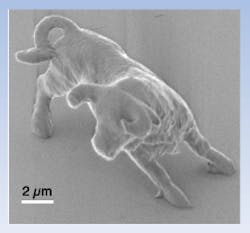
Osaka University (Osaka, Japan) researchers recently sculpted a bull roughly the size of a single red blood cell (10 µm long by 7 µm high) using two infrared laser beams and a resin that solidifies only where the lasers cross. The tiny bull's creators hope that the technology will one day find applications in medicine and computing.
The research team, led by Satoshi Kawata, professor of applied physics, demonstrated that two-photon photopolymerization makes it possible to exceed the diffraction limit by nonlinear effects to give a subdiffraction-limit spatial resolution of 120 nm. This allows functional micromachines to be created and, according to the researchers, shifts the wavelength of photonic and optoelectronic devices into the visible and near-infrared region.
"We chose a bull for the demonstration and evaluation of our technology because it has a very sophisticated three-dimensional (3-D) shape with sharp tips, as well as a smooth and partially rough body," explains research team member Hong-Bo Sun.
To sculpt the bull, the researchers used a commercially available resin consisting of urethane acrylate monomers, oligimers, and photoinitiators that is transparent to infrared laser light. The resin was photopolymerized by two-photon absorption to create the 3-D shape. A fabrication resolution of 150 nm was necessary to craft the tiniest features. By pinpoint-scanning the laser focus according to preprogrammed patterns, designs can be faithfully replicated.
"As the only technology that has intrinsic 3-D manufacturing capability, two-photon photopolymerization could find applications in diverse fields such as nanophotonics, micromachines, microelectromechanical systems, and biology," says Sun. "For example, the technology could be used in the fabrication of 3-D photonic crystals for extremely small lasers; complex 3-D micromachines running in the human body for drug delivery, manipulator, or surgery; and micro/nano sensors such as a flow sensor and an accelerator. In addition, the potential applications of two-photon absorption (but not photopolymerization) include 3-D terabyte optical data storage and stimulation and surgery inside a cell."
REFERENCE
- S. Kawata et al., Nature 412, 697 (Aug. 16, 2001).
About the Author
Sally Cole Johnson
Editor in Chief
Sally Cole Johnson, Laser Focus World’s editor in chief, is a science and technology journalist who specializes in physics and semiconductors.
